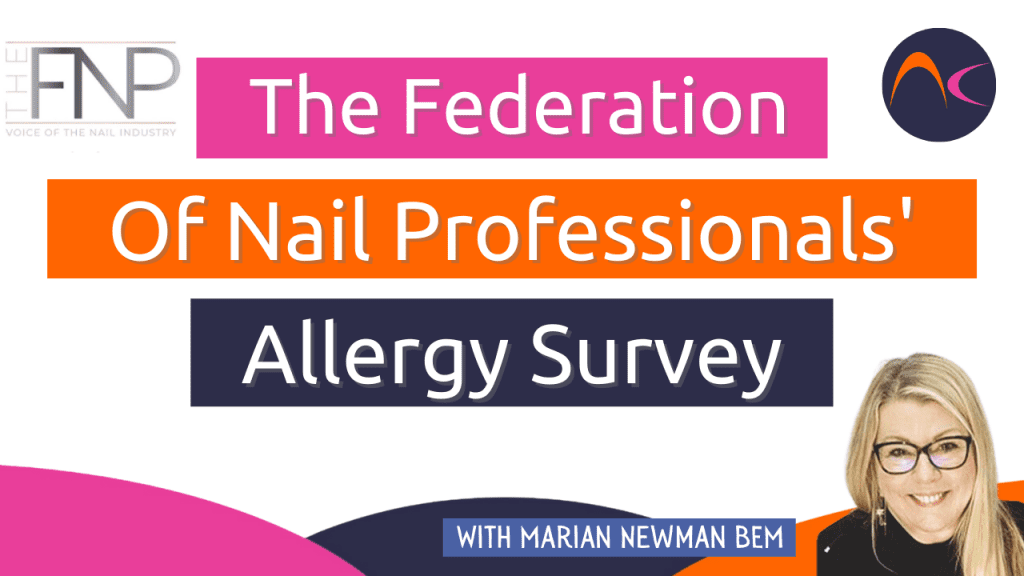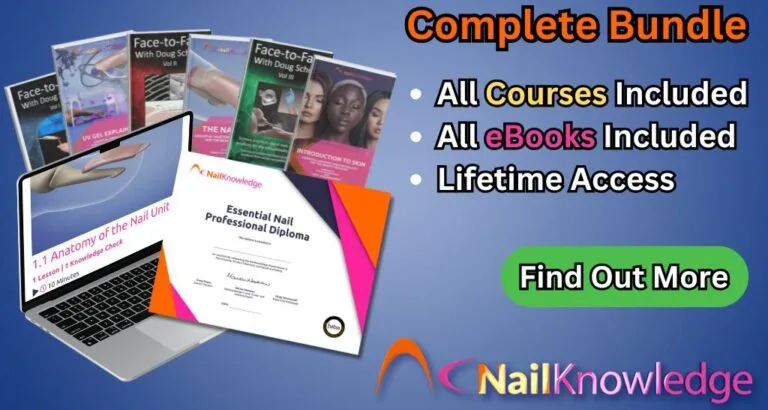A large part of the nail sector is aware of the ‘allergy epidemic’ that we and our clients are suffering from. (Surprisingly, there are still many that are not aware of it).
Acrylate-based nail coatings have been available and used since, at least, the late ’70s. There were, of course, incidences of allergies that will naturally occur in some people. Plus the occasional incidence due to ‘overexposure’ (a situation that should be included in EVERY training course for beginners and how to avoid it). We would expect these to be lower than 10% for all users. This has been the case up until around the mid 2010s. Then………..wow!
The British Association of Dermatologists identified the situation in 2018, mostly due to the rise in allergies in consumers of retail UV cured products (aka UV gel polish). This situation had, of course, spilled over into the professional sector. Nail professionals and their clients were experiencing unusual and, often, very severe symptoms. The symptoms were puzzling but, with some recent research, the situation is becoming clearer.
(Hay un vídeo gratuito sobre algunas de estas investigaciones y la mecánica de cómo se producen las alergias en www.nailknowledge.org)
The Federation of Nail Professionals is in many conversations at Government level to look at the type of products that are causing problems. Trading Standards have a lot of reported information on unwanted symptoms.
However, anecdotal information is one thing but the authorities need ‘numbers’! With this in mind, #thefeds decided to create an ‘allergy survey’ to understand, in some way, the numbers that las alergias están pasando a clavo profesionales y sus clientes. Lo llevamos a cabo durante el mes de febrero y lo difundimos todo lo que pudimos. Tuvimos unos 600 participantes en total (aunque no todos respondieron a todas las preguntas).
La encuesta era anónima y el informe completo se ha enviado a la Oficina de Seguridad de los Productos y Normas (parte de BEIS). Debido a los fondos disponibles, #thefeds no pudo crear una encuesta y un informe profesionales, así que lo que tenemos es lo mejor que pudimos conseguir.
The biggest problem is the fact that so few with symptoms were able to get a dermatological patch test, as the NHS waiting list is 12-24 months, and a private consultation costs several £100’s.
La situación pandémica empeoró las cosas. Pero debo subrayar que el problema era anterior a la pandemia.
Ante la dificultad de descubrir exactamente qué ingredientes causaban los problemas (además de una desastrosa falta de educación y comprensión), muchos siguieron probando marcas diferentes que, en realidad, no hacían más que agravar el problema.
However, I am able to share a lot of our findings. It isn’t easy reading!!
Hicimos muchas preguntas, primero a los profesionales de las uñas y luego a sus clientas. Estos son algunos de los resultados:
De 584 respuestas 28% han experimentado reacciones no deseadas.
Pero sólo 12% han recibido resultados dermatológicos (de 313 respuestas).
This mostly is due to either lack of availability, private costs, or no inclination or time! This also means that allergic reactions are, largely, self-diagnosed!! Not only that, there is no information on exactly which ingredient/s are the cause! How can anyone without that diagnosis know what the way forward is? Trying out different brands is NOT the answer.
El tiempo que tardó en mostrar una reacción no deseada es mayor entre menos de 6 meses y ¡6-12 meses! 49% cayó en esta franja. ¡Esto demuestra lo rápido que puede ocurrir! 18% tardaron más de 2 años y 15% más de 5 años.
According to our survey, 74% used a matching UV lamp. This is a good result. However, it must be said that those taking the survey are mostly those that care about their career and clients, and are well educated. There are so many that are unreachable or are in total denial that matching systems MUST be used.
From the messages I receive, it is clear that both regulated and accredited courses have teachers who are also in denial about this important fact! (The new NOS addresses this massive issue).
Another interesting response is that, out of 247 responses, a massive 64% have changed brands! But have they changed to a brand that suits them and their clients? Hypoallergenic is good but there is no guarantee that no allergies will occur.
Of 487 responses, it is half that uses a HEMA-free brand. HEMA is NOT the ‘evil child’! It is the % that is key! BUT 89% have not experienced any unwanted reactions to HEMA free (323 responses).
Ahora, a los clientes. ¡¡Un enorme 38% han experimentado reacciones no deseadas!! (de 591 respuestas) ¡Sin duda, son 30% de más y, potencialmente, 38% de clientes perdidos! Desgraciadamente, muchos de ellos no se han sometido a las pruebas del parche.
With regard to ‘home use’ or DIY’ers, from 314 responses, 24% have been those clients.
Al igual que en el caso de los profesionales de las uñas, la duración de los síntomas de los clientes, en su mayoría (48%), oscilaba entre 0 y 12 meses.
There are a lot of responses on what symptoms have been exhibited. But in the absence of medically diagnosed symptoms, the majority are ‘recognised’ rather than diagnosed. Suffice to say that onycholysis, hyperkeratosis, irritated skin, blistered, itchy, dry, and cracked skin are the most common. Usually more than one of these together. The extreme reactions have been a totally destroyed nail plate.
Lo que es una vergüenza es que 63% (265 respuestas) no se hayan puesto en contacto con la marca. 94% (286 respuestas) no se han puesto en contacto con ninguna autoridad. Parece que muchos han leído muchos mensajes en las redes sociales y se han dado cuenta de que no se obtendrá mucho apoyo con esta acción. Por desgracia, esto también significa que las autoridades no tienen ni idea de la magnitud del problema para poder actuar.
De otro proyecto de investigación reciente (al que sólo tienen acceso las autoridades) se desprende la siguiente conclusión:
– Isobornyl Acrylate (IBOA) and Hydroxymethyl Methacrylate (HEMA) in high percentages are the most common problems in the ingredients.
– Applying a coating too thickly causes an undercuring of the product.
– Using a mismatched UV lamp can cause undercuring.
– A high percentage of monomers has been proved to cause ‘leeching’ during the wearing of a coating if undercured. (Leeching is where unreacted monomers in the coating are escaping the coating onto the skin during normal wear, causing unwanted reactions.)
In conclusion, this epidemic can be pinpointed to a ‘perfect storm’ of imports (in the mid 2010s) that have a high percentage of monomers in their formulas PLUS a total lack of good education with the proliferation of ‘not fit for purpose’ short courses.
So many of these short courses are NOT qualifications. At best they are CPD (Continued Personal Development) that should follow a robust beginner course, whether regulated or accredited. Insurance underwriters and their brokers have made the whole situation much worse by purporting to insure the ‘CPD’ courses as ‘qualifications’ but not supporting claimants if needed. A few have blatantly admitted that, while people pay them, they will continue with this totally unethical practice.
Regulations for our sector WILL be coming in! It will take a while but it will involve regulated qualifications. Let us hope, by that time, the regulated qualifications Awarding Organisations will get their “houses in order” and provide qualifications that the sector can be confident in. They are NOT there yet!
The FNP is working tirelessly to make sure all of this will be ‘fit fr purpose’ for our sector. But we do need you to join! AND brands to financially support us! Do you want an industry in 10 years’ time??
This report deals with products and allergies. Please keep your eyes open for a video that will deal with the personal aspect of this situation. Those that have experienced mental health problems, lost their careers and £1000’s. Plus the perspective of a client. All of these interviews will be assessed by a medical health practitioner to explain the personal impact and how to deal with it. It isn’t all about the money. There are real people in real situations that are suffering from this situation.
Gracias por su lectura. Todo esto son hechos y no hay opiniones de por medio.


